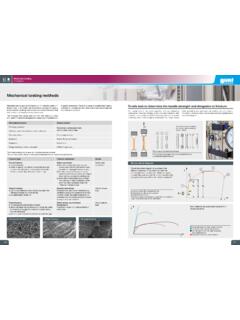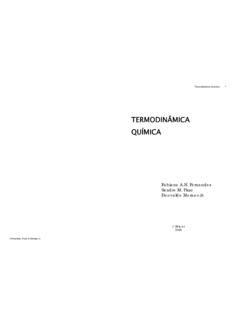Transcription of Basic Knowledge Thermodynamics of the Refrigeration Cycle
1 27 Refrigeration Thermodynamics OF THE Refrigeration CYCLEBASIC KNOWLEDGETHERMODYNAMICS OF THE Refrigeration CYCLEHeat dissipationduring condensationHeat absorption during evaporationgh pressureHigGaseousLiquidLow pressureLIsothermal compressionpIsothermal expansionWet steamboiling temperatureLiquidsupercooledCompres-sion Liquidsupercooled gpboiling temperatureSet-up and function of a compression Refrigeration systemThe refrigerant in a compression Refrigeration system flows through a closed Cycle with the following four stations: Evaporation A Compression B Condensation C Expansion DThe cooling takes place in the evaporator (A).
2 The evaporation takes place at low pressures and tempera-tures. Here the refrigerant absorbs heat from the envi-ronment and thus cools it. The still cold refrigerant steam is aspirated by a compressor (B) and subjected to higher pressure by using mechanical energy. The refrigerant steam heats up due to the compression. The hot refrigerant steam is cooled down in a condenser (C) and condenses while discharging heat to the envi-ronment. The liquid pressurised refrigerant is then expanded to the low evaporation pressure in an expansion element (D) and returned to the evaporator. The refrigerant evaporates again and thus completes the cyclic process can be represented very clearly in the T-s the temperature T of the operating medium is plotted above Tthe entropys.
3 The area enclosed by the change of state of the operating medium corresponds to the work realised in the cyclicprocess. The cyclic process with the highest possible efficiency is theCarnot Cycle , here the enclosed area is a rectangle. This Cycle isoften used as a comparison Cycle to describe the quality of the cyclic direction of the cyclic process in theT-sdiagram determinesswhether this is a heat pump Cycle ( Refrigeration Cycle ) or a workmachine Cycle (steam power Cycle ). Refrigeration cycles are anti-clockwise and the work represented by the green area is added to the process of a simple compression Refrigeration systemCompressor powerIdeal cyclic process (Carnot Cycle ) of a gaseous medium in the T-s diagramThe log p-h diagram for refrigerantThe Refrigeration cycleFor operating media which can have different phases,such as water or refrigerant, theT-s diagram looks has an area on the left (grey),in which the operatingmedium is liquid and supercooled.
4 In the centre(blue)there is a mixture of steam and liquid, the wet the right of it(orange) the operating medium is inpure steam form and real Refrigeration Cycle with its typical phase tran-sitions can also be represented in this T-s Cycle has many similarities to the familiar steampower Cycle . The major difference is that the Cycle isanticlockwise. Thus the processes of evaporation andcondensation and expansion and compression (pump-ing) swap enclosed area (green)corresponds to the compres-sor work added to the the log p-h diagram the pressure pis plotted above thepenthalpy the centre(blue) is the wet steam area.
5 Here the temperature corresponds to the boiling temperature for the pressure. The wet steam area is surrounded by limit curves with the steam content x= and x= To the left of it(grey) the refrigerant is liquid. The tempera-ture is below the boiling temperature for the pressure; therefrigerant is the right(orange) the refrigerant is gaseous and thetemperature is above the boiling temperature. The refrig-erant is superheated. Every refrigerant has its own log p-h log p-h diagram is better suited to represent the refrig-eration Cycle than the T-s diagram and is therefore used energies exchanged with the refrigerant modify the enthalpy h of the refrigerant.
6 Energy flows can be readdirectly from the diagram as horizontal content xGaseoussuperheatedlog p-h diagram for refrigerantRefrigeration Cycle in the T-s diagram29 Refrigeration Thermodynamics OF THE Refrigeration CYCLEBASIC KNOWLEDGETHERMODYNAMICS OF THE Refrigeration CYCLEh1 - h4 COP =h2-h1 NameFC R134aFC R404aFC R407aNH3 R717 Isobutane R600aCO2 R744 Boiling temperatureTs = -26 CTs = -47 CTs = CTs = -33 CTs = -12 CTs = -78 CPure substanceMixtureMixturePure substancePure substancePure substancePressure in bar aTemperature in CThe Refrigeration Cycle in the log p-h diagramThe Refrigeration Cycle in the log p-h diagramThe real Refrigeration Cycle consists of the following changes of state:1 2 polytropic compression on the condensation pressure (for comparison 1 2 isentropic compression)2 2 isobaric cooling, deheating of the superheated steamIn addition there are also pressure losses in the real Refrigeration Cycle , which means that evaporation and condensation are not exactly horizontal (isobaric).
7 3 3 isobaric cooling, supercooling of the liquid3 4 isenthalpic expansion to the evaporation pressure1 1 isobaric heating, superheating of the steam4 1 isobaric evaporation2 3 isobaric condensationEnergy considerations in the log p-h diagramThe horizontal distances of the key Cycle points in thelog p-h diagram correspond to the enthalpy differences. In thesimple Refrigeration Cycle without branched off mass flows theseresult in the energy flows or capacities of the ideal system whenmultiplied with the refrigerant mass flow. The distances in thelog p-h diagram are therefore a direct measure for the energyflows exchanged.
8 The distance 4 1 corresponds to the cooling capacity and is thenet capacity of the Refrigeration system. The distance 1 2 is thedrive power exerted via the compressor. The distance 2 3 corre-sponds to the heat capacity discharged via the condenser. This isthe waste heat of the Refrigeration the ratio of the net capacity and the drive power the coef-ficient of performance COP can be coefficient of performance can be compared to the efficiencyin a work flows in the Refrigeration Cycle cooling capacity absorbed compressor drive power heat capacity dischargedImportant for a good operation is the steam pressure curve of the operating medium.
9 It should be gaseous at low pressures and at the desired cooling tempera-tures and liquid at high pressures and temperatures. The pressure levels should also be easy to diagram shows the steam pressure curve of thewell suited FC R134a. Typical freezing temperatures of -26 C in the evaporator can be implemented with pressures around 1bar while for condensing only apressure of 17bar at 60 C is required. While in pure substances, such as NH3, propane andCO2,, the steam pressure curve is fixed, it can be adapted in FC within wide boundaries to meet require-ments by mixing different base grades.
10 Steam pressure curve of FC R134aThe refrigerantEvery cyclic process requires an operating medium whichin the Refrigeration Cycle is the refrigerant. In the refrigera-tion Cycle the refrigerant has the purpose of transporting heat. Here the high absorption of energy during evapora-tion or discharge of energy during the condensation of a liquid is utilised. To achieve this at the temperatures prevailing in a Refrigeration system at well manageablepressures, liquids with a low boiling point, such as differ-ent fluorocarbons (FC), ammonia (NH3), carbon dioxide(CO2) or hydrocarbons such as butane or propane, are used as operating medium.



